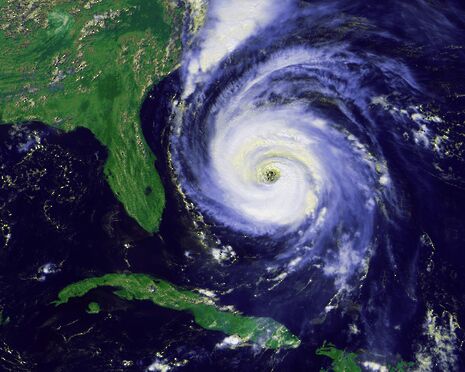Our planet’s vital signs
Sofia Weiss looks at how climate change has been implicated in the hurricanes of recent times

It is difficult not to be sensationalist when writing about climate change. The temptations are two-fold: to succumb to apocalyptic lines of thinking regarding our planet’s future; or conversely, to focus entirely on berating the new-wave of ‘climate change deniers’. Of course, it does not help when the latter group is championed by the President of the United States with his unforgettable statement that “the concept of global warming was created by the Chinese.” Given, however, the seemingly unending volley of tropical cyclones that have barrelled across the Atlantic in recent months, and the environmental questions that their occurrence poses, it is worth establishing discussion on a middle ground.
The principle concern that has emerged from Harvey, Irma and further storms of their ilk is whether some threshold of our changing climate has been crossed, and if so, whether humans are responsible. Accumulated research would suggest that the answer is mostly no, but with troubling undertones of yes. Overall, the United States National Climate Assessment of 2017 concludes that “the trend signal has not yet had time to rise above the background variability of natural processes.” Whilst it is premature to conclude that human activities have had a pronounced impact on Atlantic hurricane or global tropical cyclone activity, it is possible that we may have caused smaller changes that are not yet detectable. More worrying still are the conclusions of Princeton’s Geophysical Fluid Laboratory that anthropogenic warming by the end of the 21st century will highly likely cause tropical storms globally to be more intense on average; by anywhere between 2 and 11%, from model projections. This change would imply an even more significant percentage increase in the destructive potential per storm, assuming no reduction in storm size.
In the age of fake news, it is clear both that climate change is real and that the vital signs of our planet are compromised because of it
Hurricanes commence with the evaporation of warm seawater, dragged upwards when converging winds collide, until, at increased altitudes, the water vapour begins to condense into rain. Simultaneously, the pressure at its core will successively drop, sucking in wind with vacuum-like action at ever increasing velocities. Over several hours to days, the storm will intensify, finally reaching hurricane status when the winds that swirl around it reach sustained speeds of 74 miles per hour or above. What proves key here is that as surface temperatures in the ocean rise, so too does the probability of hurricanes forming. This is where the plausible influence of global warming comes to the fore - and according to NASA, the current warming trend is of particular significance not only because most of it is extremely likely to be the result of human activity since the mid-20th century, but also because it is proceeding at an unprecedented rate.
The Intergovernmental Panel on Climate Change, a group of 1,300 independent scientific experts from countries the world-over acting through the United Nations, stipulates that the industrial activities that our modern civilisation depends upon have raised atmospheric carbon dioxide levels from 280 parts per million to 400 parts per million in the last 150 years. These emissions, alongside our production of other gases such as methane and nitrous oxide, have caused much of the observed increase in Earth’s temperatures over the past 50 years.
In the age of fake news, it is clear both that climate change is real and that the vital signs of our planet are compromised because of it. Whilst all hope is not lost – greenhouse gas emissions are now falling in many countries as a result of programmes such as fuel-economy standards for cars, stricter building codes and emissions limits for power plants. It is in this context, much easier to understand why storms are named after people
 Features / How sweet is the en-suite deal?13 January 2026
Features / How sweet is the en-suite deal?13 January 2026 Comment / Will the town and gown divide ever truly be resolved?12 January 2026
Comment / Will the town and gown divide ever truly be resolved?12 January 2026 News / 20 vet organisations sign letter backing Cam vet course13 January 2026
News / 20 vet organisations sign letter backing Cam vet course13 January 2026 Arts / Fact-checking R.F. Kuang’s Katabasis13 January 2026
Arts / Fact-checking R.F. Kuang’s Katabasis13 January 2026 Music / Inside Radiohead’s circle13 January 2026
Music / Inside Radiohead’s circle13 January 2026









